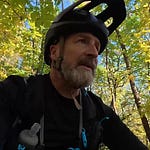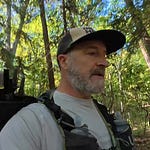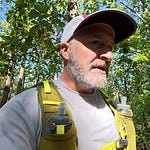The twinge in my right knee shot through me on a downhill stretch at mile eleven. Not good. With the temperature hovering at 30 degrees and that damp winter chill penetrating my layers, body parts choosing now to complain seemed particularly inconvenient.
The Test
A simple test: Would my week of sleep schedule overhaul and pre-bed magnesium translate to trail performance? After contradictory midweek runs—one "productive," one "maintaining"—today would be the verdict. My goal for the run: 20K.
I layered methodically. Craft top, wind-blocking vest, tights, shorts. Olympus 6 with gaiters for the sandy, debris-prone sections. Backpack instead of vest—unloaded except for water, phone, and camera.
Initially, I committed myself to a 10K with the option of cutting it short at 15K or the full 20K, depending on how things felt. The actual data would come from comparing today's performance with the loaded 10-pound pack run scheduled two weeks out.
Trail Challenges
The pine-covered sections transported me momentarily to New England childhood, but nostalgia faded when hitting the varied terrain. My pace dropped—from a surprising 42-minute first 5K to a more gentlemanly 44-minute second segment.
Sandy trails forced more walking breaks than planned. My average speed settled at 4.3 mph—slightly below my historical 4.4-4.5 on this loop.
No birds today. Just the smell of distant winter fires and the sound of my footfalls on sandy trails. The real surprise came from my Garmin: a +3 performance condition reading. After months of zeros and occasional ones or twos, seeing that number felt like validation.
The Decision Point
Seven miles in, I faced the crossroads. 15K or push for 20K?
The mental math kicked in. I'd recently completed a 15K ruck that took nearly three hours. A 20K run would require about the same time investment.
"What's the worst that's going to happen? I get a strain status? Whatever."
The third 5K segment came in predictably slower—46 minutes. Hills announced themselves more forcefully now. "This is the third to last hill... The next one is the biggest."
With STP cranking in my headphones, I settled into the work. By the 10-mile mark, my pace had stabilized at 4.2 mph—slower than the target but remarkably consistent. Heart rate data showed I was almost entirely in Zone 2. The engine was running efficiently.
One of the weird things I noticed: my legs felt heavy—like they would when filled with lactic acid—but they weren't actually tired.
"And the more I recognize it, the more I realize that's just fitness."
Intuitively, you know that. But experiencing it is different. Feeling like you should be tired, but you're not. It's empowering.
The Final Push
The last 5K loop brought the actual test. That knee twinge demanded attention on every downhill—nothing serious, but there. I'd felt it around the house yesterday—probably from sitting awkwardly—but now it was making its presence known.
System check: Engine running adequately. Feet surprisingly comfortable. Shoes didn't feel heavy despite 1,300+ feet of elevation gain. Pace felt glacial, and my legs felt full of cement.
The final hills demanded negotiation with every step. Each one was a simple contract: just maintain 4.2 mph, keep the heart rate reasonable, and keep moving forward.
Crossing the Line
The final 5K clicked off in 45 minutes, bringing me to 20K in just under three hours. Then came the parking lot at 12.91 miles, forcing one last decision.
"Do I do two tenths of a mile just to make it a half marathon? I think so."
Those final steps brought me to 13.15 miles—ensuring it would register as a proper half marathon on Strava—in 3:09:37.
"Got to get the extra for Strava. So it's called a Strava half marathon."
The roast beef and coleslaw wrap waiting at home never tasted better.
What I Learned
Today revealed the hidden power of recovery. A week of consistent sleep schedules and magnesium supplements had paid dividends. My average heart rate of 144 bpm with less than 10% of the run above Zone 2 confirmed what I was feeling—the system was working efficiently.
That distinction between heaviness and fatigue is everything. The sensation no longer automatically signals the need to stop. It's just data—information about how the body is working.
The most valuable outcome: establishing a baseline. I'll tackle this exact route again in two weeks but with 10 pounds in the pack. Today's run with just water, phone, and camera (maybe 4-5 pounds total) provides the perfect comparison point.
"I'm finally, well, at least at the moment, out of unproductive or strained."
Sometimes, the most valuable training isn't about pushing harder but about intelligently setting up the next challenge.
Final Stats
Here's the breakdown for those keeping score:
Distance: 13.15 miles (half marathon)
Time: 3:09:37
Average Pace: 14:25/mile
Heart Rate: Avg 144 bpm
Elevation Gain: 1,542 feet
Heart Rate Zones:
Zone 2: >90%
Zone 3: <10%
Training Effect: 4.0 aerobic
Training Status: Maintaining
Recovery Time: 36 hours











